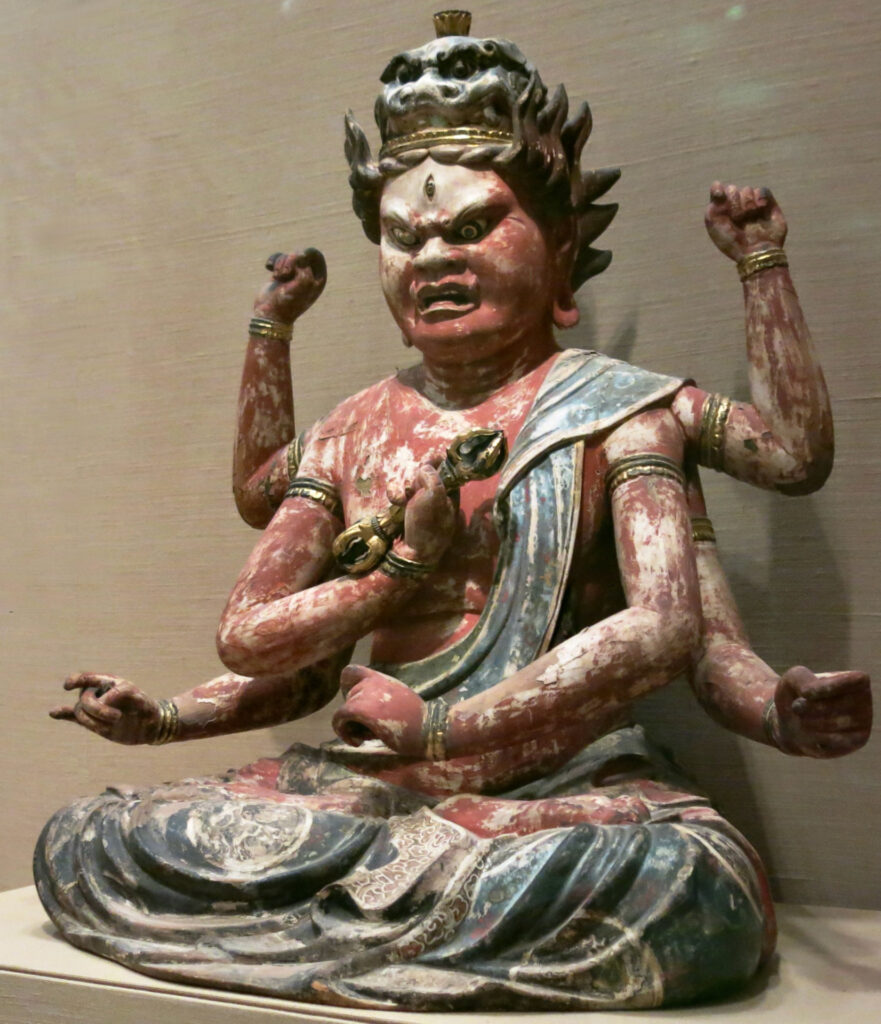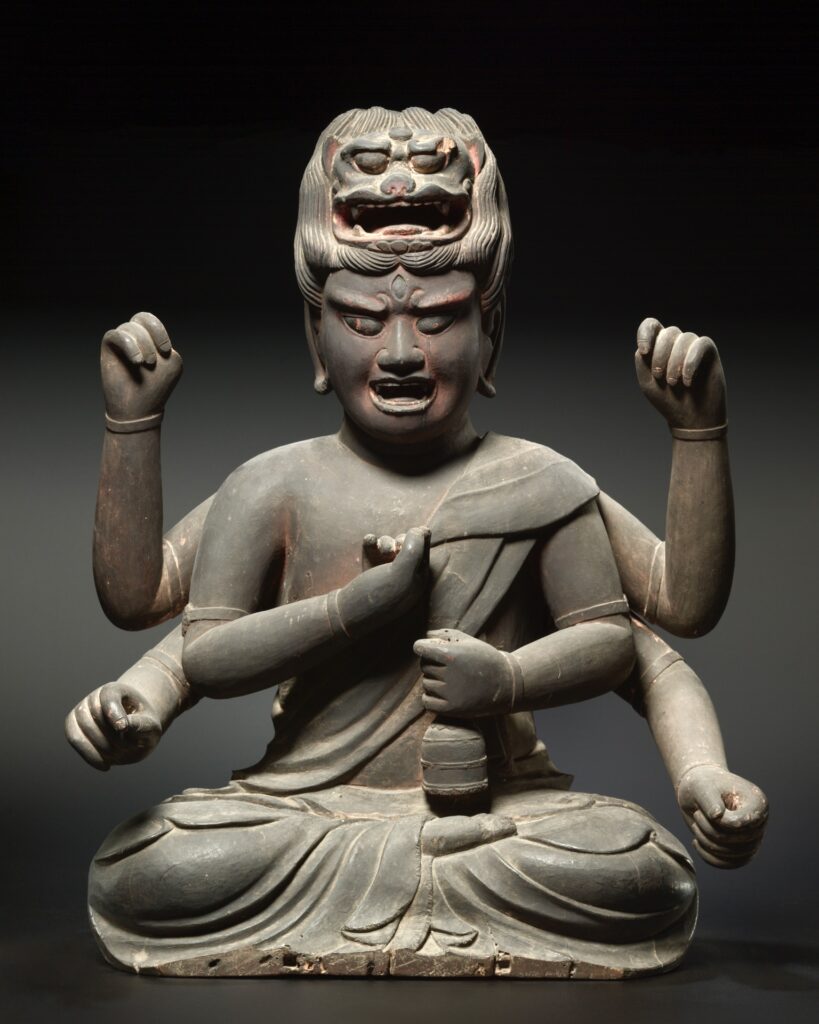The Asian Museum of Art in San Francisco has a polychromed wood sculpture of Aizen Myo-o, the Japanese name for the esoteric Buddhist deity of love and passion. His original Sanskirt name is Ragaraja. I have very little understanding of esoteric Buddhism, so rather than get some details wrong, here’s a 1916 description of Aizen myo-o’s attributes and iconography from a Japanese English-language publication:

Aizen Myo-o, by Noritake Tsuda (expert in the Tokyo Imperial Museum), The Japan Magazine: A Representative Monthly of Things Japanese (Japan Magazine Co., Tokyo), vol 7, no 7, November 1916, pp. 401-402:
“Another familiar Buddhist deity is Aizen Myo-o, though he is not so widely popular as Fudo [Myo-o], treated in our last number of the Japan Magazine. Aizen Myo-o is the Indian god known in Sanskrit as Raga-vidyaraja. Raga usually means color, especially red, which symbolizes love or affection. Vidya means finding, and Raja a king; and sometimes the Sanskrit name used for this deity is Namu-vajra-raga-vidyaraja, or again simply Ragaraja.
“Aizen Myo-o is said to be a partial incarnation of Kongo-satta, in Sanscrit Vajrasattva, who took an oath to expel from mankind all wicked passions and to hasten the coming of all men to Buddha, giving them happiness and good fortune.
“This god is represented commonly in red with three terrible eyes, six arms, the figure seated on a lotus pedestal with lion headdress. Some ideas associated with the iconography of Aizen Myo-o may be inferred from one of the old masterpieces of painting representing him. The most beautiful and interesting of these is in the Hobodai-in temple in Kyoto. The painting is now a national treasure, and at present is on view at the Imperial Museum, Tokyo. A minute examination of the piece shows that the body and features have been painted in red. In the sutra referring to this deity, his heart and body are said to shine as the sun; and it is probable that the red color was selected to represent this, as well as to suggest reality. The gaping, terrible eyes sparkle marvelously in the red face, one of the eyes being placed lengthwise between the usual two. The three eyes are to give the beholder an impression of terror and awe as well as to suggest that this god has the oversight of three different aspects of the world. The eyes are blue with golden eyebrows. The mouth is open and has a grotesque grin with teeth gleaming, a common characteristic of Aizen to represent truth indestructible; the Logos, which, in Buddhism, is symbolized by the first letter of the alphabet.
“The hair on the head of Aizen stands erect in bizzare fashion, and a cap, in shape like a lion, is placed on the head with a fine-pointed kongo-sho stuck in it. The erect hair is intended to symbolize the subjugation of all evil agents. In his first left hand Aizen holds a bell; and in his first right hand another kongo-sho, both of which are symbols of mercy, bringing the peace of Vajrasattva to men. In the second left hand he holds a bow and in the second right hand an arrow, to dispel the four demons and the three other obstacles of man, shooting especially the pessimistic passions. The third left hand is extended in a grasping attitude with nothing in it, and in the corresponding right hand a lotus bud is just opening, the gesture suggesting that the bud is to be thrown at something. This symbolizes the driving out of all worldly trouble by lotus-like purity. The red lotus on which the god is seated, typifies the stability of his will. In front of the pedestal stands a treasure jar, around which are scattered treasure symbols, which suggest the bounty of the deity to all in need.
“It is noticeable that red is the prevailing color in the icons of this deity; and this is always so, because in esoteric Buddhism red always stands for love and the faculties that make for affection and compassion. The painting just described comes down from the 12th century and may be taken to represent Aizen Myo-o in his most orthodox form.
“Several other forms, however, are found among the representations of him, as, for example, some with four heads or two heads and four hands, but such divergences from the conventional form are rare.
“The Aizen Myo-o is the god of the upper classes chiefly, especially since the Fujiwara period, as he is believed to have the power of staying calamities, or gaining happiness, for those who serve him. On occasions of worship an altar of red is erected and a red image of Aizen is placed thereon; and the officiating priests are also robed in red.
“There now remains in Japan some 21 representations of Aizen Myo-o which are listed as state treasures. In addition to the painting above mentioned there is a very beautiful one on silk in the Gokokuin in Tokyo, as well as a very fine gilt statuette of him in the Imperial Museum, Tokyo, which is dated February, 1297 A.D.”
So wrote Noritake Tsuda in 1916. More recently, as can be seen in the Wikipedia entry for Aizen myo-o, there have been Western attempts to recast Aizen myo-o as a deity of same-sex male love and passion. It’s an interesting possibility, but I don’t know enough to judge if this is merely Western wishful thinking, or a considered appraisal of the historical record.
It appears that Aizen myo-o spread beyond Buddhist circle into Shinto rites. In their book Shinto in History: Ways of the Kami (Routledge, 2018), John Breen and Mark Teeuwen document how Aizen myo-o was part of a kanjo or Shinto initiation rite:
“The kirikami [i.e., written notes] of this [Shinto] initiation further reveal that the syllable un, that is at the heart of the ritual, represents not only the mind of enlightenment, but is also the seed syllable (shuji) of Aizen Myoo or King Raga. This figure (which is also bright red) represents human lust and desire, and personifies the insight that one’s innate desires are no other than inherent enlightenment itself…. The practice revealed in Ise kanjo thus teaches the practitioner that the kami [i.e., Shinto deity or power] dwells in his own heart/mind. The initiate is taught to visualize the kami as the syllable un, representing both the mind of enlightenment and his innate desire, in the guise of Aizen Myoo. The insight to be gained from this is that enlightenment and desire are identical…. The kirikami go on to teach that the kami of the Inner and Outer Shrine of Ise appear in our world as a golden and a white snake…. both the kami of Ise and [of] Aizen Myoo are snakes….” [pp. 103-104]
The case of Aizen Myo-o shows yet again that it’s unwise to assume that a deity belongs exclusively to one tradition and has only certain specified attributes. That’s an assumption Westerners, especially Protestants (and their offspring, the crusading atheists), like to make, but it’s often incorrect. Deities tend to have regional variations, just as Ragaraj became Aizen myo-o when he left India fro Japan.. Deities may move between traditions, just as Aizen Myo-o moves between the porous boundaries of Japanese Buddhisms and Shinto. And deities may have more than one manifestation, just as Aizen myo-o can be both a humanoid with six arms and three eyes, and, at an esoteric level, a snake.
You can find quite a few photographs of Aizen Myo-o sculptures and paintings online. The Cleveland Museum of Art has posted the following photograph with a CC0 license, which allows me to repost it here:

A note on orthography: Usually there are macrons over both “o”s in the Romanization of this deity’s Japanese name: Aizen My?-?. And there are supposed to be macrons over the first and third “a”s in the Sanskrit name: R?gar?ja. However, diacritical marks don’t always translate well in all web browsers, so I’ve left them off.
Part of a series on deities.
My definition of “deity.”
